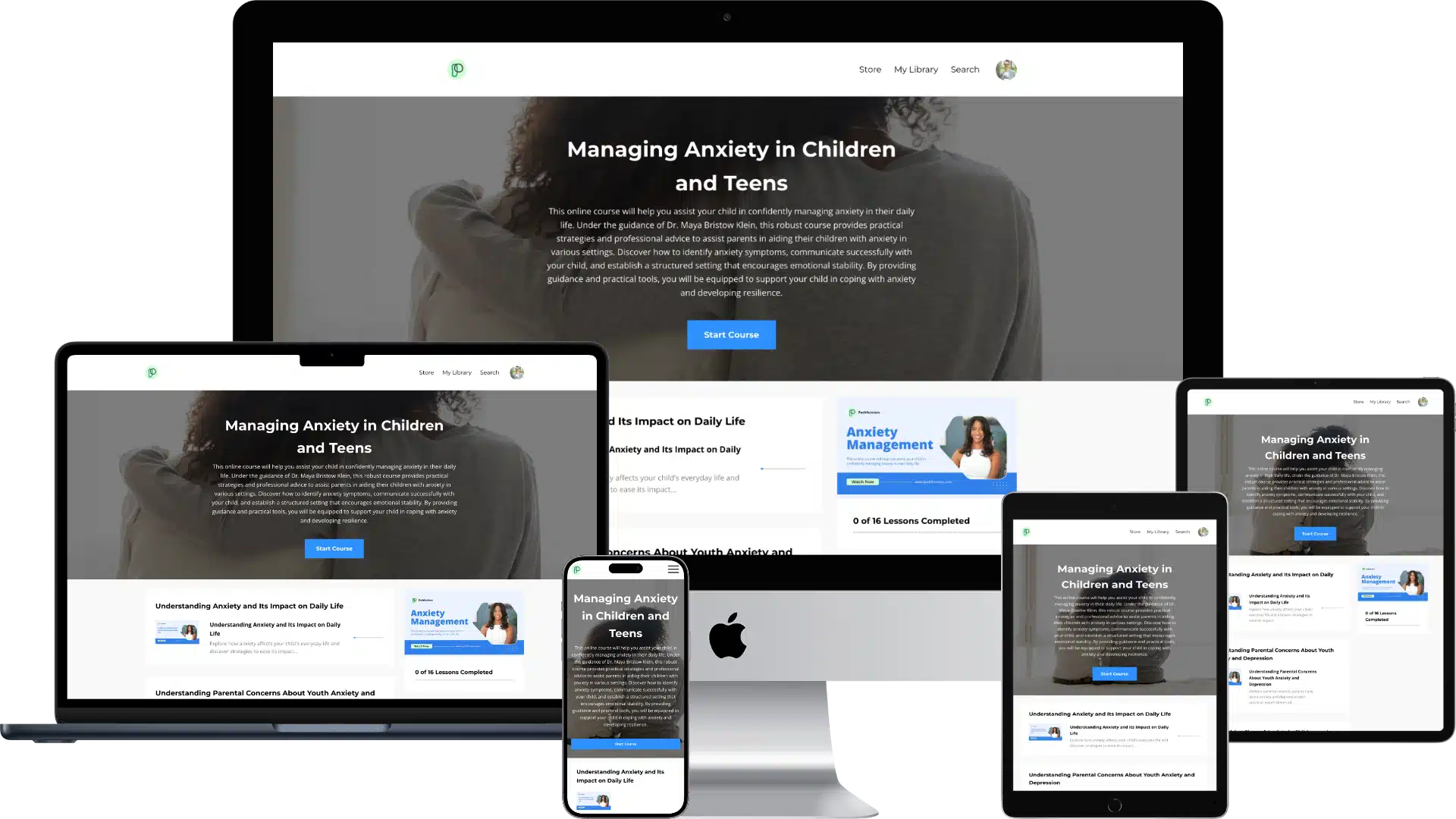Pave the Way for Your Child’s Success in Managing Anxiety
Managing Anxiety in Children and Teens
This online course will help you assist your child in confidently managing anxiety in their daily life. Under the guidance of Dr. Maya Bristow Klein, this robust course provides practical strategies and professional advice to assist parents in aiding their children with anxiety in various settings. Discover how to identify anxiety symptoms, communicate successfully with your child, and establish a structured setting that encourages emotional stability. By providing guidance and practical tools, you will be equipped to support your child in coping with anxiety and developing resilience.
Watching your child deal with anxiety can be incredibly tough and frustrating. You’ve probably spent hours reading, talking to friends and family, researching, and trying different strategies, but you still feel:
- Unsure how to spot the signs of anxiety
- Struggling to talk to your child about their worries
- Helpless when anxiety disrupts their daily life
- Frustrated by not finding reliable solutions that actually make a difference
At Pathformers, we’ve encountered these same struggles with families countless times, which led us to create “Managing Anxiety in Children and Teens.” This online course, taught by Dr. Maya Bristow Klein, is designed to help you understand your child’s anxiety and give you the tools to really make a difference in how they learn and cope during this challenging time.

Helping Your Child Overcome Anxiety One Step at a Time
We’ve broken down the overwhelming world of anxiety into clear, manageable steps so you can feel more confident about helping your child.
Here’s how the course will help:
Recognizing Anxiety
Learn how anxiety shows up in kids and teens so you can catch the signs early and prevent them from snowballing.
Talking to Your Child About Anxiety
Discover ways to talk to your child that help them open up, feel understood, and feel safe.
Creating Structure for Calm
Get tips on creating a routine at home that cuts down on anxiety triggers and promotes calm.
Understanding Different Types of Anxiety
Learn about different types of anxiety, from social anxiety to generalized anxiety disorder, and how to handle each one.
Supporting Emotional Ups and Downs
Learn how to help your child manage their emotions when anxiety hits and deal with the worries that come with it.
Exploring Treatment Options
We’ll walk you through various treatments and therapies so you can find the best fit for your child.
Anxiety affects every part of your child’s life, but with the right support, you can help them manage their fears and feel more in control.
Parents Like You Trust Pathformers
A Peek Inside the Course
Dr. Maya Bristow Klein will guide you through each module, making the topics around anxiety feel understandable and actionable. You’ll also get worksheets and tools to help put what you’ve learned into progress with your child.
Here’s a look at the modules so you know exactly what to expect:

Understanding Anxiety and it’s impact on daily life
Explore how anxiety affects your child’s everyday life and discover strategies to ease its impact.

Understanding Parental Concerns About Youth Anxiety and Depression
Addressing Rising Mental Health Challenges in Children and Teens

Recognizing Signs of Anxiety in Children and Teens
Discover how to identify both subtle and obvious signs of anxiety in your child.

Long-Term Effects of Anxiety
Learn about the potential long-term effects of anxiety and how early intervention can make a difference.

Understanding the difference between worry and anxiety
Identifying the Subtle Yet Crucial Differences Between Worry and Anxiety in Children and Teens

Fear and Anxiety: Knowing the Difference
Learn to differentiate between fear and anxiety and how to help your child manage both.

Helping Your Child Navigate Anxiety
Guiding Your Child Through Internal and External Stressors

Causes of Anxiety – Root Emotions
Understanding the psychoanalytic distinction between traumatic anxiety and neurotic anxiety in children and teens.

Types of Anxiety: Traumatic and Neurotic
Understanding the Two Faces of Anxiety Through a Psychoanalytic Lens

Understanding Moral Anxiety in Children
Navigating the Tension Between Internal Expectations and External Pressures

Generalized Anxiety Disorder
Understanding the Signs and Supporting Your Child Through Constant Worry

Social Anxiety Disorder
Recognizing and addressing the fear of social situations and judgment.

Obsessive-Compulsive Disorder
This course explores Obsessive-Compulsive Disorder (OCD) in children, focusing on persistent, unwanted thoughts and repetitive behaviors. You will learn effective strategies to manage these thoughts, reduce compulsive actions, and build resilience.

Post-traumatic stress disorder
This course explores PTSD in children, focusing on its unique symptoms and causes. At the end of this course you will understand the broad and sweeping ways that trauma can effect mental health.

From Roots to Wings: Healing Attachment Across Generations
Understanding and Transforming Attachment Styles for Healthier Relationships

A Clear Perspective on Anxiety
Wrap up with a clear, big-picture view of anxiety management, setting your child up for long-term success.

On the Road to Emotional Balance and Growth
You don’t have to figure this out on your own. With expert advice, real strategies, and tools you can actually use, this course gives you the confidence to support your child through anxiety—whether at home, at school, or wherever they need it.
Frequently Asked Questions
What will I learn in the “Managing Anxiety” course?
You’ll learn techniques for recognizing anxiety, understanding its causes, and managing symptoms using mindfulness, relaxation exercises, and cognitive-behavioral approaches.
How can I help my child manage anxiety?
The course offers relaxation exercises and communication strategies to help children cope with anxiety at home and school.
What are the signs of anxiety in children?
You’ll learn to identify signs like excessive worry, fear, avoidance, and physical symptoms like headaches or stomachaches.
What is the difference between worry and anxiety?
The course clarifies the distinction between typical worries and anxiety disorders, helping parents know when it’s time to seek help.
Can anxiety lead to other mental health issues?
Yes, untreated anxiety can contribute to conditions like depression. The course offers strategies to reduce long-term mental health risks.
What Are the Comorbidities of Childhood Depression?
Childhood depression, also known as depressive disorders in children and adolescents, often coexists with other mental health conditions. These comorbidities can intensify challenges and necessitate an integrated approach for effective management. Below, we explore the most common comorbidities, their implications, and strategies for support.
What Is Comorbidity in Childhood Depression?
Comorbidity refers to the presence of one or more additional disorders alongside depression in children and adolescents. This coexistence complicates diagnosis and treatment, impacting the mental health and overall well-being of the affected individual.
What Are the Most Common Comorbidities of Childhood Depression?
1. Anxiety Disorders
- Overview: Includes generalized anxiety disorder, social anxiety, and panic disorder.
- Prevalence: Many children with depression also exhibit symptoms of anxiety, creating a complex clinical picture.
- Impact: Heightened emotional distress, impaired functioning, and challenges in school and social settings.
2. Attention-Deficit/Hyperactivity Disorder (ADHD)
- Overview: Symptoms of hyperactivity, impulsivity, and inattention often overlap with depression.
- Prevalence: Studies estimate that 13% to 27% of children with ADHD also experience depression.
- Impact: Requires tailored treatment strategies to address both conditions effectively.
3. Conduct Disorder
- Overview: Characterized by aggressive or antisocial behaviors.
- Impact: Coexisting conduct disorder can exacerbate behavioral issues, increasing academic and social difficulties.
4. Substance Use Disorders
- Overview: Adolescents with depression are at higher risk for substance use disorders.
- Impact: Substance use worsens depressive symptoms and hinders recovery.
5. Learning Disabilities
- Overview: Conditions like dyslexia often coexist with depression.
- Impact: Struggles in school contribute to low self-esteem, exacerbating depressive symptoms.
What Are the Risk Factors for Comorbidity in Childhood Depression?
Common risk factors include:
- Family History: A genetic predisposition to depression or anxiety.
- Stressful Life Events: Trauma, abuse, or significant life changes.
- Developmental Challenges: Cognitive, emotional, or social difficulties that increase vulnerability.
How Does Comorbidity Affect the Treatment of Childhood Depression?
Comorbidities often require:
- Integrated Approach: Simultaneously addressing depression and co-occurring disorders.
- Therapeutic Strategies: Adapting interventions like cognitive-behavioral therapy (CBT) to manage overlapping symptoms.
- Monitoring and Adjustment: Regular evaluations to assess progress and modify treatment plans as needed.
How Can Parents and Caregivers Support Children with Comorbid Depression?
Parents and caregivers play a vital role in supporting children with depression and comorbid conditions. Key steps include:
- Seek Professional Help: Work with mental health specialists trained in child and adolescent care.
- Encourage Open Communication: Foster a safe, non-judgmental environment for children to share their feelings.
- Promote Healthy Habits: Ensure routines include sufficient sleep, regular exercise, and a balanced diet.
- Stay Informed: Learn about your child’s specific comorbidities to better understand and meet their needs.
What Are the Next Steps for Managing Comorbidities in Childhood Depression?
- Early Diagnosis: Timely identification improves outcomes.
- Comprehensive Treatment Plans: Collaborate with professionals to tailor strategies to your child’s unique needs.
- Consistent Support: Maintain a supportive home environment and prioritize regular check-ins with healthcare providers.
For more resources and expert guidance on managing childhood depression and its comorbidities, explore Pathformers’ educational materials and advocacy programs. Together, we can provide the support children need to thrive.
Help Steer Your Child’s Development
Subscribe to our newsletter for exclusive video updates, expert parenting strategies, and the latest insights in child development and mental health.




